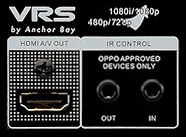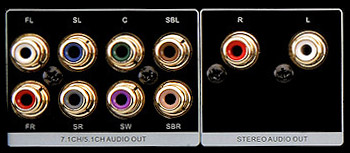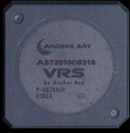|
Oppo Digital is very much a
newcomer to the world of home video. Yet despite the
company's relative youth, it has an excellent reputation and
a mountain of accolades under its belt thanks to its
well-received upconverting DVD player models. The BDP-83
is the company's first foray into the Blu-ray market,
arriving
several years after the debut of the likes of Pioneer,
Panasonic and Sony. Many of these large manufacturers are
now producing their fourth generation of Blu-ray machines, with
mature offerings available from all. Entering this
market is a challenge for any company, but one Oppo seems
willing to accept.
Indeed, Oppo's first Blu-ray
machine could never be called a half-hearted effort. It
fully supports both Blu-ray profiles 1.1 and 2.0, and comes
with 1GB of onboard memory. It features internal decoding of
Dolby TrueHD, Dolby Digital Plus, DTS-HD Master Audio and
DTS-HD High Resolution audio, and plays both SACD and
DVD-Audio discs as well as CDs and a variety of compressed
audio formats over HDMI or through its eight-channel RCA
analogue outputs. Its video capabilities are equally
impressive, and include 1080/24p output, VRS video
processing and scaling, 24p playback for DVD and a source
direct mode for use with external video processors.
Like contemporaries SVS and
Outlaw Audio, Oppo's products are only available for purchase
online and won't be found in typical brick-and-mortar retail
outlets. In New Zealand, Oppo's range of products is
imported by Auckland-based online reseller
RapalloAV.
In addition to the stock machine, RapalloAV also offers a locally modified region-free/selectable (for
both DVD and Blu-ray) BDP-83 for NZ$1399; it is this machine
that is reviewed below (a NZ$300 premium over
the Region A machine). The BDP-83 can also be purchased in its
untouched Region A/Zone 1
state directly from
Oppo
Digital for US$499 and shipped from the US. The player's
power supply accepts 100-240V at either 50 or 60Hz, meaning a stepdown transformer is not required in
240V 50Hz New Zealand.
Unboxing
When first removed from its box, the BDP-83's build quality
is reassuringly industrial. It's a solidly built player
weighing a little over 5kg, with an elegant, matt-black
metal fascia minimally populated with only a power and eject
button, and a round cluster of command buttons. At the far
right of the front panel, barely visible behind a rubber
gasket, is a USB port which can be used to play various
video and audio formats, upgrade the player's firmware, or
expand the player's 1GB of internal storage. A second USB
port is also be found on the rear panel.
Included in the box is a 1.8m HDMI cable,
the usual assortment of analogue cables, the remote control,
power cord, and two Blu-ray discs (one a setup disc, the
other an HD audio demo disc). The player is presented in a
tightly-fitting nylon carry bag printed with the Oppo logo. At around 8 cm
in height, including feet, it isn't as slim as the latest
offerings from Panasonic, Pioneer or Sony, but it appeared
positively waif-like beside a 23kg Onkyo AV amplifier.

HDMI Output
Video
and Audio Connections
Connecting the player to a TV or receiver is simple,
especially if using HDMI
cables: one cable between the Oppo and a receiver or TV and you're done.
For analogue video there are only composite or component
video outputs to choose from: no S-Video. Although Oppo has
provided these analogue connections for greater backward
compatibility, they should be avoided if possible, as only
the HDMI output uses the player's Anchor Bay VRS processor. This player is definitely
geared for the digital video (HDMI) market in this respect.
If analogue audio is required,
there are two choices: the eight-channel RCA cluster which utilize a
single Cirrus Logic CS4382A DAC, or a dedicated stereo RCA
pair which use Cirrus Logic's flagship CS4398 DAC, as found
in Bryston's megabuck BCD1 CD player. All ten analogue
audio outputs are gold plated.

Analogue RCA Audio
Setup
and Initial Run
Initial player setup is a breeze thanks to a clear and
concise, full-colour, quickstart onscreen guide. After
answering a brief series of questions about cabling and the
type of equipment being connected, the Oppo should be up and
running in less than five minutes. One of the first
impressions of the BDP-83 is of sheer speed.
Older Blu-ray players have typically taken a minute or more
merely to turn on, and additional minutes to load Blu-ray
discs utilizing the thorny mess that is BD-Java. The Oppo is typically on and playing any given Blu-ray disc in less
than 30 seconds. The time between pressing the eject button
in standby to the disc tray opening is a mere three seconds.
For DVD and audio the Oppo's operational speed is even
faster, beginning playback of SACDs almost instantly. Only
on extremely java-intensive Blu-ray discs does the player
begin to lag (Blu-ray java torture-test 'Terminator 2:
Skynet Edition' took just over 42 seconds to load to its
first menu, for example). The player's speed brings Blu-ray
closer to what most are accustomed to from DVD.

BDP-83 Remote Control
Remote
Control
The Oppo's remote control unit
is backlit, with a logical layout and easy to read text.
It's also large, sitting comfortably even in large hands.
Reactions to commands from the player are immediate, and all
of the most important functions are intuitively positioned. The remote control also allows users to
change the player's video output resolution on the fly. This
is a feature I have only seen from Pioneer before, and it is
surprisingly useful. Among the resolutions that can be
selected is a 'Source Direct' option which outputs the video disc's
native format (typically 480/576i for DVD and 1080/24p for Blu-ray),
entirely bypassing any additional processing. This feature is
particularly useful for those using external video
processors. A button in the bottom right-hand corner of the
unit activates the remote control's backlight, but a second
press does not turn it off and the light stays on for around
eight seconds before switching off; this is just slightly
longer than necessary in many cases. Virtually none of the
remote control's buttons are duplicated on the player's
front panel, so this is one remote you don't want to lose
down the side of the couch!
In Operation
In use the player is mechanically very quiet, with the drive
motor audible only during the disc's initial spin-up and
when stepping through chapters. There is a small cooling fan
positioned on the player's back panel, but it was quiet and
never audible during movies or when listening to music, and
only once while pausing a film.
Mechanically, the only slight disappointment is the disc tray,
which is loud when opened or closed and less sturdy
than I would have liked. It also lacks the silky-smoothness
of the disc trays on flagship Denon, Sony or Pioneer
machines, but this has no impact on player
performance.
The front LCD panel is large and can be viewed clearly from
a distance, displaying information about the disc being
played and connections in use. The display can also be dimmed or turned off
(coming back to life briefly after each remote control
command). Likewise, the player can be coaxed to present an onscreen
display on a connected television of projector, providing
such information as the playback time,
audio and video formats, combined video and audio bit-rate
(but not separate audio and video bit-rates, which is
information I always find interesting and is often found on
conventional DVD players),
chapters, titles and other information. When
playing music, track details are displayed onscreen as well
as disc art if present, and a screen saver can be activated
for plasma TV owners.
Audio Performance
The BDP-83 is the world's first 'universal' disc player. It
will play virtually every five inch disc format currently in
production, from CD, DVD, DVD-Audio and SACD through to Blu-ray
(but not Toshiba's now-defunct HD DVD format). It will also
play a variety of audio formats on USB flash drive or
external USB hard drive via its front and rear USB sockets.
The Oppo features comprehensive onboard audio decoding,
including the elusive DTS-HD Master Audio, and HDMI 1.3a for bitstreaming of Dolby
TrueHD, Dolby Digital Plus, DTS-HD HR and MA to suitable
processors.
True to this
promise the Oppo played DVD, CD, Blu-ray and SACD without
any problems (no DVD-Audio discs were available to test). It
can, if required, also stream raw DSD from SACD over HDMI (or converted
to PCM if required). The Oppo is only the third SACD player
I am aware of with this capability. I preferred the sound of direct DSD,
but the differences between DSD and its PCM conversion are
probably best left to debate by dedicated audiophiles.
Bitstreaming DTS-HD MA and
TrueHD soundtracks to an external decoder was problem free,
with no dropouts or other issues. As expected, bitstreamed
audio from the player sounds identical to that of every
other player I have tested with this capability. High
resolution audio decoded to PCM is slightly quieter than via
bitstreaming, but again exhibited no other audible
difference, and is the configuration of choice for listeners
with older pre-1.3 specification HDMI receivers.
It is only when using the
analogue audio connections that the player's sonic
characteristics become apparent, with the Oppo acquitting
itself well with SACD and HD audio from Blu-ray, with very
neutral reproduction. There is no obvious low or high
frequency emphasis to speak of, which some regard as adding
character ('warmth' or 'airiness'), and I was able to
happily sit for several hours without listener fatigue. CD
playback is also excellent, if slightly disappointing when
immediately following a well-recorded SACD or movie
soundtrack.
Video
Performance
Despite the player's expansive audio support, video quality
has not been overlooked.
The Oppo possesses a solid video pedigree thanks to onboard VRS
video processing courtesy of Anchor Bay's ABT2010 scaler/deinterlacer
processor. Running through the usual array of test sequences
and patterns the de-interlacer managed to quickly lock on to
even the most unusual cadences and editing anomalies,
producing excellent results from everything thrown at it.
The Oppo's scaling is equally capable, producing strong
1080p images from DVD with no artificial ringing or
stair-stepping, and without sacrificing sharpness for
smoothness.

Anchor Bay ABT2010
Unusually, the player is also
capable of converting HD video between 60Hz and 50Hz. This
may be a useful feature for those with equipment that does
not support 50Hz PAL, SECAM or HD sources, but in my tests
the results weren't ideal with jerky pans and what looked
like dropped frames. Other useful features include a common
height zoom for those using anamorphic projection lenses,
and an underscan 'zoom' for those using monitors that cut
off the edges of the active picture area. These are both
unusual features, but extremely important for a small
segment of buyers, and demonstrate a pleasing consideration
for potential users from Oppo's engineers.
Viewed at 100 inches through a
suitably calibrated Panasonic 1080p LCD projector, 1080/24p
Blu-ray playback was excellent, with strong colour
reproduction, excellent detail and a smooth, artefact-free
image that easily matches or betters that of any other
player I have seen regardless of price. The BDP-83 presented my first
opportunity to test 24p playback from DVD (NTSC discs only).
This feature is also found on some of
Panasonic's newer Blu-ray players and Toshiba's
discontinued HD DVD
machines, and requires a compatible display. The removal of
3:2 pulldown from DVD, with its associated image judder,
combined with excellent 1080p scaling is a compelling
combination and brings new life to old DVDs. With previous Blu-ray players, viewing DVDs
has largely been a chore with less than satisfactory picture
quality requiring a dedicated DVD player, but
with the Oppo it was a pleasure and demonstrated there is
still performance to be squeezed out of the format. Blu-ray
playback from the Oppo is undoubtedly stellar, but it is
perhaps this finesse with DVD that is its greatest
revelation.
Conclusion
The BDP-83 offers fantastic picture quality from Blu-ray
and, more impressively, superb DVD picture quality. It is
also a superior all-round audio player with the ability to
replace several different audio and video components in one
fell swoop, and features best-of-class features and speed.
Paradoxically, however, it may be most suited for those with
an eye on the past thanks to its ability to bring new life
to the venerable DVD format.
It's impossible not to be
impressed with this machine. Given its price, capabilities
and polished performance it could well be the best value Blu-ray
player on the market today. If you're thinking of buying a new Blu-ray
player, or upgrading your current player, the Oppo BDP-83
should be somewhere on your shortlist, if not at the very
top.
|